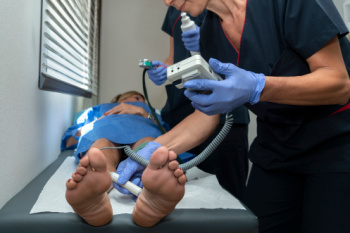
Vascular testing of the feet by podiatrists is a critical diagnostic tool in assessing blood flow and circulation, especially in patients with diabetes or peripheral artery disease. Podiatrists employ various techniques to evaluate vascular health, including ankle-brachial index, or ABI measurements, Doppler ultrasound, and toe pressure measurements. ABI compares blood pressure in the ankle to that in the arm, indicating potential arterial blockages. Doppler ultrasound assesses blood flow velocity and direction, identifying narrowing or blockages in arteries. Toe pressure measurements gauge the pressure in the toes, offering insight into distal circulation. Indicators for conducting vascular testing include symptoms like leg pain, wounds that do not heal, or changes in skin color or temperature. Obstacles to performing these tests may include time, limited access to equipment, or patient discomfort. If you notice discomfort in your feet and toes that may indicate a circulation issue, it is strongly suggested that you schedule an appointment with a podiatrist so that if vascular testing is needed, it is done so in a timely manner.
Vascular testing plays an important part in diagnosing disease like peripheral artery disease. If you have symptoms of peripheral artery disease, or diabetes, consult with Charles Passet, DPM from Forest Hills. Our doctor will assess your condition and provide you with quality foot and ankle treatment.
What Is Vascular Testing?
Vascular testing checks for how well blood circulation is in the veins and arteries. This is most often done to determine and treat a patient for peripheral artery disease (PAD), stroke, and aneurysms. Podiatrists utilize vascular testing when a patient has symptoms of PAD or if they believe they might. If a patient has diabetes, a podiatrist may determine a vascular test to be prudent to check for poor blood circulation.
How Is it Conducted?
Most forms of vascular testing are non-invasive. Podiatrists will first conduct a visual inspection for any wounds, discoloration, and any abnormal signs prior to a vascular test.
The most common tests include:
- Ankle-Brachial Index (ABI) examination
- Doppler examination
- Pedal pulses
These tests are safe, painless, and easy to do. Once finished, the podiatrist can then provide a diagnosis and the best course for treatment.
If you have any questions, please feel free to contact our office located in Forest Hills, NY . We offer the newest diagnostic and treatment technologies for all your foot care needs.

